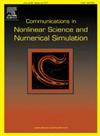随机欺骗攻击下反应扩散项延迟惯性神经网络的马尔可夫切换同步及其在图像加密中的应用
IF 3.8
2区 数学
Q1 MATHEMATICS, APPLIED
Communications in Nonlinear Science and Numerical Simulation
Pub Date : 2025-06-16
DOI:10.1016/j.cnsns.2025.108997
引用次数: 0
摘要
研究了随机欺骗攻击(DA)影响下具有反应扩散(RD)项的延迟惯性神经网络(DINNs)的钉住同步(PS)问题。通过采用马尔可夫切换控制策略,选择特定神经元作为固定控制节点,并在马尔可夫跳跃实例中应用反馈控制输入,分析了动力学。将随机DAs建模为随机脉冲,基于一致稳定函数(USF)和马尔可夫过程的无穷小发生器,导出了关于马尔可夫切换系统的第p阶指数收敛的引理。这些引理有助于制定足够的准则,使dinn与RD在DA中同步,确保均方收敛。即使在钉住反馈输入下,某些误差系统可能会发散,但保证钉住反馈控制器遵循马尔可夫切换,可以使整个误差系统实现均方收敛。为了验证理论结果,给出了数值算例,验证了所提同步方案的有效性。本文提出了一种将dinn与RD混沌序列相结合的图像加密方案,利用Knight’s Tour国际象棋置乱和Hilbert曲线变换引入双重混淆机制。混沌序列与双混淆的融合提高了加密的强度和安全性。为了验证密码系统,进行了广泛的统计度量、安全性分析和鲁棒性评估,以证明其对攻击的有效性和实际适用性。本文章由计算机程序翻译,如有差异,请以英文原文为准。
Pinning synchronization of delayed inertial neural networks with reaction–diffusion terms under stochastic deception attacks using Markov switched control and its application to image encryption
This research delves into the pinning synchronization (PS) of delayed inertial neural networks (DINNs) with reaction–diffusion (RD) terms, under the influence of stochastic deception attacks (DA). By employing Markov switched control strategies, where certain neurons are selected as pinned control nodes, and feedback control inputs are applied at instances of Markov jumps, the dynamics are analyzed. The stochastic DAs are modeled as stochastic impulses, and to tackle this, lemmas concerning the th moment exponential convergence for Markov switched systems are derived based on the uniformly stable function (USF) and the infinitesimal generator of Markov process. These lemmas facilitate the formulation of sufficient criteria for the synchronization of DINNs with RD amidst DA, ensuring mean square convergence. Even if some error systems may diverge under pinning feedback input, ensuring that the pinning feedback controller follows Markov switching can lead the overall error system to achieve mean square convergence. To substantiate the theoretical findings, numerical examples are provided, demonstrating the validity and effectiveness of the proposed synchronization schemes. We propose a novel image encryption scheme that combines DINNs with RD chaotic sequence, introducing a dual confusion mechanism using Knight’s Tour chess scrambling and Hilbert curve transformation. The integration of chaotic sequences with dual confusion enhances encryption strength and security. To validate the cryptosystem, extensive statistical measures, security analyses, and robustness evaluations are performed, demonstrating its efficacy against attacks and practical applicability.
求助全文
通过发布文献求助,成功后即可免费获取论文全文。
去求助
来源期刊

Communications in Nonlinear Science and Numerical Simulation
MATHEMATICS, APPLIED-MATHEMATICS, INTERDISCIPLINARY APPLICATIONS
CiteScore
6.80
自引率
7.70%
发文量
378
审稿时长
78 days
期刊介绍:
The journal publishes original research findings on experimental observation, mathematical modeling, theoretical analysis and numerical simulation, for more accurate description, better prediction or novel application, of nonlinear phenomena in science and engineering. It offers a venue for researchers to make rapid exchange of ideas and techniques in nonlinear science and complexity.
The submission of manuscripts with cross-disciplinary approaches in nonlinear science and complexity is particularly encouraged.
Topics of interest:
Nonlinear differential or delay equations, Lie group analysis and asymptotic methods, Discontinuous systems, Fractals, Fractional calculus and dynamics, Nonlinear effects in quantum mechanics, Nonlinear stochastic processes, Experimental nonlinear science, Time-series and signal analysis, Computational methods and simulations in nonlinear science and engineering, Control of dynamical systems, Synchronization, Lyapunov analysis, High-dimensional chaos and turbulence, Chaos in Hamiltonian systems, Integrable systems and solitons, Collective behavior in many-body systems, Biological physics and networks, Nonlinear mechanical systems, Complex systems and complexity.
No length limitation for contributions is set, but only concisely written manuscripts are published. Brief papers are published on the basis of Rapid Communications. Discussions of previously published papers are welcome.
 求助内容:
求助内容: 应助结果提醒方式:
应助结果提醒方式:


